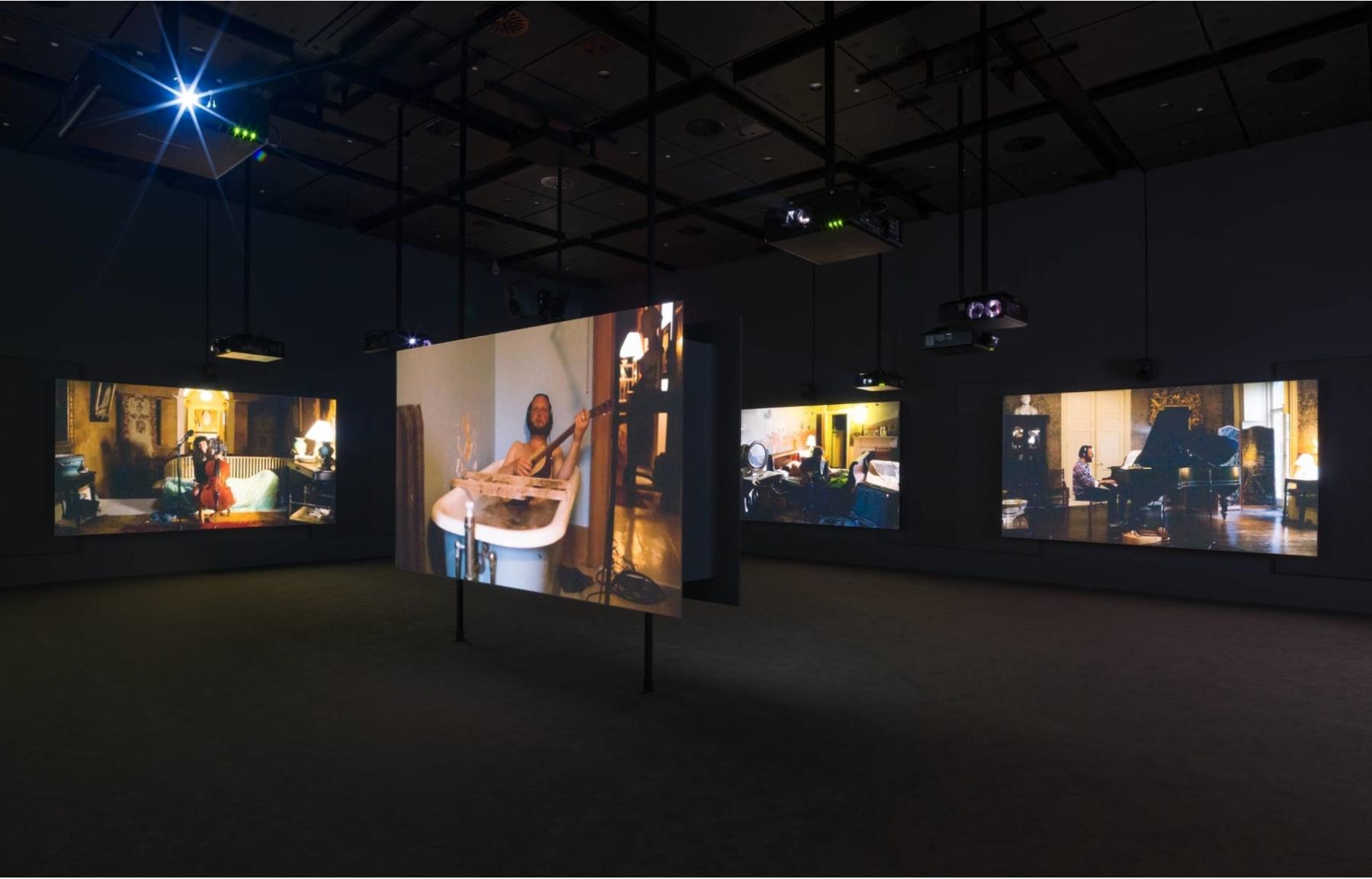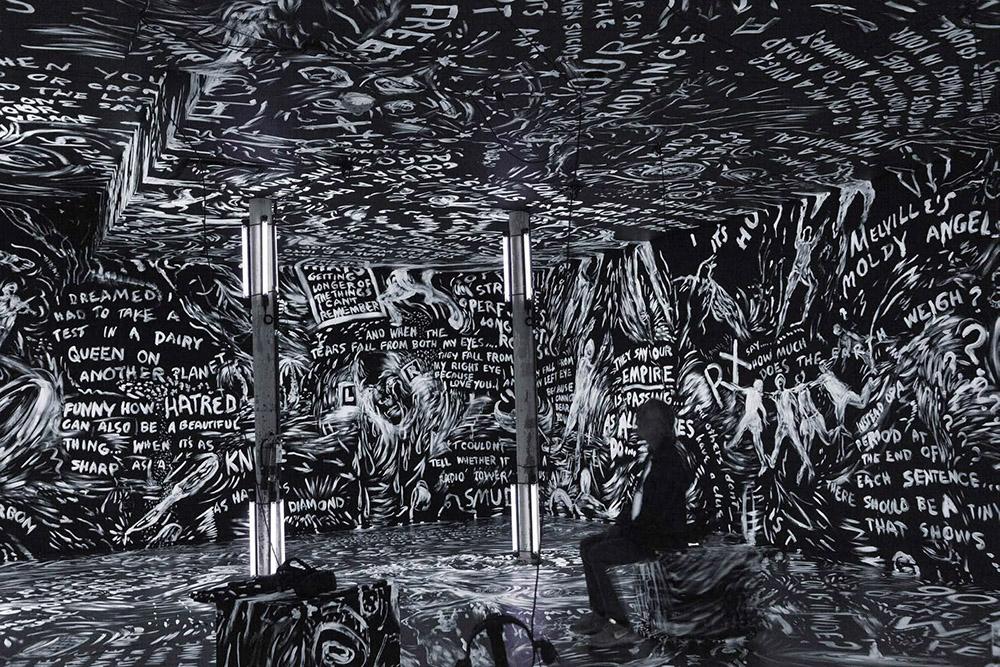
Farzad Owrang @ Ragnar Kjartansson/Courtesy of the Artist, Luhring Augustine New York and 18 Gallery, Reykjavik. Installation view of "The Visitors" Via: City Beat
Late one early-autumn night, I crawled through the narrow tunnel of a plastic Klein bottle constructed on my college campus. The 3D equivalent of a Möbius Strip, the bottle was a skeleton of flexible PVC pipes and a skin of clear plastic stitched to it with white twine. To guard against mild winds, the bottle was staked to the ground and pulled taut, tied to the bare branches of the trees above. My crush crawled through first, and I followed into the wide arched belly of the bottle. We lay side by side talking for hours, shielded from the light rain outside. Maple leaves plinked against the walls and as the wind picked up, the plastic rippled.
I. something which manages to touch my desire1
There is something intimate in being horizontal: lying side by side, gazing into the face of your lover or at the same strange tilted perspective: the wrinkled sheets that mountain and valley around you, the blades of grass that shade your views, or the unfamiliar slant of things. When you are horizontal, you share new spaces, physically and visually. Experiencing visual art can have a similar effect: lines direct the gaze, and those that emphasise horizons and horizontal elements invite an intimacy that parallels laying horizontal or making eye contact. As the eyes of many different viewers are pulled in the same direction, the artwork invites a sense of intimacy through sharing a gaze, a perspective. I.e. I walk into the museum with my innocence or bursting excitement or sleepiness; I walk in with my own history, understanding and context. Then I am confronted by a scene2 which is also a meeting ground, a defined and particular environment where my perspective merges with the other viewers’ and the artwork becomes multi-dimensional through this shared perspective and shared viewing.
Vertical lines guide viewers, as do diagonals, convex curves, and more but horizontal lines emulate ultimate boundaries: horizons, sometimes even event horizons––that which one cannot reach beyond, and which is a fixed distance at all times. Distance becomes a finite boundary to the effect that viewers in an installation are held in the gaze of, and enveloped by the limits of the same constructed worlds. At a certain point, you are flush against the edge––as close as one can get, perhaps physically or in your familiarity with the work, and intimate in this way. You cannot peel back from the artwork without having known it closely; and in that moment to your fullest extent.
The Tate Modern defines installation art as a “complete unified experience.” It is an artwork that occupies and/or engages the entirety of a defined space. Aiming at effecting a presence or atmosphere, the artwork “creates a high level of intimacy between itself and the viewer as it exists not as a precious object to be merely looked at.” Installation art strives to immerse the viewer and often considers the viewer an element of the artwork itself.

François Boucq's "Tour d'horizon" (2021)
In summer 2021, the Palais des Beaux Arts in Lille, France, invited a local graphic novelist to reinterpret the gallery spaces. Tour d’horizon, one of the installations in Open Museum – Francois Boucq trompe l’oeil, metamorphosized the Landscape Gallery into a landscape. Paintings hung in one long row, frames kissing all around the perimeter of the room. A thin blue rope traced the single horizon. Peering through the door frame, the room looked nearly ordinary; but stepping into the panoramic view, crossing the boundary into the installation, the deviations from the standard curation stood out. Although not everyone would see it as such, Tour d’horizon exemplified installation art––it was site specific, temporary, and defined by its relationality to the viewer. Whereas paintings are normally displayed separately and spaciously in the Landscape Gallery, sometimes at eye level and sometimes higher up, Tour d’horizon constructed a unified visual experience. The installation acted as a whole greater than the sum of the paintings in the room––and engaged with a trend in art criticism to compare installation art to paintings. Ilya Kabakov, another artist famous for both his installations and writing on installation, compared his work to “a kaleidoscope of innumerable ‘paintings’”.3 Theorist Claire Bishop uses “a conventional display of paintings on a wall” as an image of contrast when defining the blurry line between installation and installation art: “An installation of art is secondary in importance to the individual works it contains, while in a work of installation art, the space, and the ensemble of elements within it, are regarded in their entirety as a singular entity. Installation art creates a situation.”4 In Tour d’horizon, no matter where one’s gaze settled along the horizon, the installation placed viewers on the same fine blue horizontal axis, immersing them in a singular environment and in the intimacy of a shared perspective.
II. “I fling myself into it”5
Lover (n.) – somebody involved in a relationship or an affair. We often assume that a lover loves another lover––that a lover must exist in a lover/lover dynamic. However, emphasising the verb that roots the word reveals more—defining lover as one who loves [x], where x can be a subject, object, atmosphere, etc. reveals that a lover is always relational, but not limited to reciprocity. Boris Vian captures the infatuation, the multitudinous of love6 in his novel L’Écume des jours:
« Je voudrais être amoureux, dit Colin. Tu voudrais être amoureux. Il voudrait idem (être amoureux). Nous, vous, voudrions, voudriez être. Ils voudraient également tomber amoureux… » (24)7
Love (n. and v.) can be passionate, obsessional, consumptive. It is intimate––an emotional or physical care which deepens, widens, grows and layers on itself in a way that illuminates the precious details of what is before you and gives familiarity a thrill and lushness. (Love is the magnitude and intimacy is the magnifier, the sharp focus that allows something so big to feel close). “S’abîmer,” Barthes begins A Lover’s Discourse, “sometimes I have a craving to be engulfed”8. He explores the desire to merge with the beloved. To dress like one’s crush, or to crawl inside their ribcage.
At its best, installation art can be as totalizing as the sensation of love––––

Installation view of "The Visitors" in the SFMOMA
In a video loop, time is distorted. Duration is a constant removed from context. Entering the dark room of a video installation, the viewer exits time (as we know it) and enters the loop. Ragnar Kjartansson’s installation “The Visitors” lovingly surrounds the viewer, pulling them from the museum environment and into his world. The 9-channel installation engages the room at every angle, with projections not only on the walls but in the centre of the room.9
The setting is as particular as it is intimate––the “195-year-old, 43-room stucco house on 420 rolling acres” is cluttered with nearly two decades of stuff, the residue of having been well lived. Marble busts, carved figurines and Grecian pedestals, peeling paint and ornate wallpaper, golden lamps, leather-bound books, dust, and rumpled fabrics saturate the screens with a sense of familiarity. Each channel shows a different room in the mansion and in each room, a musician. Performing Kjartansson’s ex-wife’s poem, each artist’s voice and/or instrument streams together into a single song. Wandering from channel to channel, the viewer imitates wandering between rooms. In content and in form, the video acts as a physical invitation and embodies an atmosphere of intimacy, love, and tenderness. Kjartansson invites the viewer into the scene where he strums his guitar from the bathtub; in another room, one lover plays guitar softly as his lover sleeps behind him, nude figure obscured by green bed sheets; or in yet another, friends laugh and sing on the porch, casually perched on the railings. Each space offers an intimate moment, and collectively they express the range of love: from loneliness and yearning, to shared joy.

Ragnar Kjartansson plays in a bathtub in an old mansion in his video installation “The Visitors,” coming to Chelsea next month.Credit...Ragnar Kjartansson/Luhring Augustine, New York and i8 Gallery, Reykjavik. Sourced : ICA Boston
The viewer experiences Kjartansson’s tender grief and vibrant care when the audio washes over them, crescendos, loops; viewers engage with the space through movement and, in the absence of chairs, sprawl across the floor. The presence of the viewer contributes to the work: yet another friend invited into the mansion that is the site of this song, this music video, this frolicking. One dynamic characteristic of installation art is the incorporation of the viewer as a medium; “the viewer’s spatial and temporal experience with the exhibition space and the various objects within it forms part of the work itself,” and in this work in particular “art spectators both construct and are constructed by their interactions with media screens.”10 As the viewer turns through the space and visits each room they are greeted by a new musician facing them, serenading them. Like the spectrum of reciprocity that love exists on, The Visitors effects and affects vary in strength and complication, but nonetheless evoke “a messy blend of elation and melancholy, separation and sociability, interiority and exteriority” that are all tied to love, intimacy and care.11 (Kjartansson himself approached this work with tenderness, as well as the messiness of accepting new boundaries and forms of yearning alongside his divorce).12 Parallel to how the installation art assigns the viewer to be the medium, the enveloping sensuality and other-worldliness of “The Visitors'' effaces the neutral idea of a viewer. In place, everyone who interacts with the video is a lover.
In its depths, and layered meanings and emotions Kjartansson’s work affects not only hospitable love, individual love and collective love, but also a grievous one. Installation, in its diverse forms and innate intimacy, can touch beyond the grave. In 2019, I visited “You,” an exhibit at the Musée d’art moderne de la ville de Paris. Two laundry machine doors were installed like portals in a white wall. Visitors acted as witnesses, participants, smellers. Opening the first round door, I stuck my head into the dark void within the wall, cautionless. I was struck by an odour so potent, my whole body shivered. Anicka Yi’s The Last Diamond (2015) was the scent of grief: one of death and memory, one as strong as skunk spray, and as lingering. I felt nauseous and sorrowful and a little bit hollow throughout the exhibit, and into the night.
III. “my most intimate listener. i will love you always”13
Not only were Laurie Anderson and Lou Reed lovers, they were romantics. Lovers, as defined, and romantics in the ways that they approached their relationship: striving towards ideals, tendering romantic gestures. The couple met in 1992 and lived separately for their entire twenty-one year relationship. Still, Anderson’s studio and Reed’s apartment overlooked the Hudson River and when he would see an interesting cloud, Reed would call Anderson to share the moment and the horizon with her.
The first time I saw Anderson’s videos at MASSMoCA, a black-box screening room enveloped me. Couples curled into massive square bean bag chairs that blended into the darkness of the room. Overflowing projector light caught the edges of their tangled limbs. Like many installation pieces I have seen since, the space featured “loveseats”—diverse forms of seating meant for two. At the front, a large screen looped Anderson’s Personal Service Announcements and “O Superman.”
I was visiting the museum with a friend and a part of me wished that we were more than that as the thick canvas of the seat pulled taut under the weight of our bodies, the beads shifting audibly as we settled in. I felt timid, self-conscious of the lack of romantic intimacy between us. I was hyper-aware of the sheer number of cuddling couples around us. However, as Anderson’s world enveloped me, everything changed. In “O Superman,” Anderson sings,
“Well you don’t know me, but I know you.” In assuming closeness without requiring reciprocity, Anderson creates intimacy between herself and her viewer. The tone of the song is inviting, accepting (“you can come as you are”), and loving. Void of expectation, the potential intimacy is greater. You don’t have to pick up the phone to receive the message; the lyrics are not unlike “a one-sided conversation, like a prayer,” according to Anderson. Her Personal Service Announcements do similar work, subverting the expectation that video is produced for mass consumption. Sharing her own opinions and observations, Anderson interacts with the viewer and speaks casually, impressing an intimacy on them—the viewer is personally addressed through the medium. In one PSA, Anderson leans across a diner counter, an eye-level mid-shot, as if you are in deep conversation with her, as she muses on public television programming. In “O Superman” (which loops again after the PSAs are screened) Anderson’s staccato and echoing “Ha, ha, ha, ha, ha, ha” felt like cling film wrapped around my brain. It echoed within me throughout the museum, the two and a half hour drive home, the weeks that followed. It’s still there, and when I recall the video installations, I feel a warmth that is not unlike the ways I remember my first kiss––staccato, unexpected. There is a form of intimacy akin to love that is implicit in sharing a seat, but sunk into the beanbag, I fell in love with the work before me, became engulfed.
IV. “I am dissolved, not dismembered; I fall, I flow, I melt”14
Installation art equally parallels a lover’s mentality when it inspires a sense of isolation in the viewer. Unrequited love is the ungraspability of the beloved; isolation remains “in relation to,” desiring [x]. The ultimate form of isolation is beyond distance between self and friends, families, and affairs. It is the isolation of the self from its senses. The body expects to work in cause and effect. A primal desire: when we chew, we want to taste.
Sitting in Laurie Anderson’s Chalkroom, the body is unrequited. The virtual reality installation features a black room with every surface coated in luminous chalky words and illustrations, individual swivelling square seats, goggles and hand-held devices for each participant. Under the goggles, the viewer experiences a limitless space aesthetically similar to the room. The stories react to invisible bodies—to the devices, the arms outstretched, the perspective shift that corresponds to a twisting head. Participants, their bodies eerily erased from the graphic, navigate and manipulate the space, erasing the chalk from the virtual walls, sending Anderson’s stories into a flurry of particles. At all times, there is a museum attendant, and at most times, there are simultaneous participants in the room, all invisible to each other.

Laurie Anderson, Chalkroom, Virtual Reality, 2017, © Laurie Anderson and Hsin-Chien Huang, Courtesy Sesc SP
In Chalkroom, the senses are disoriented and the participant becomes so totally immersed that to their own eyes they are visually inseparable from the installation piece. It is an extremely disorienting feeling to be submerged in an artwork like this; to feel your body––the strain of the goggles on your nose, your neck, the heft of the controllers in your clenched hands––and yet appear bodiless. This sudden disorientation invoked by the headset makes what we are most intimately familiar with (our own bodies) a thing to be missed. The effect is feeling simultaneously intensely embodied and yet missing your body, yearning to be more embodied. The body, erased, an object of desire, highlights how installation art that isolates the viewer is a form of unrequited love.
V. “Space is waiting for our love, as I am longing for you” –Yves Klein
The Klein bottle briefly transformed my college campus. Reflecting back on the experience, the moment is re-interpretable. A passing student (a viewer) gazes upon the installation (a plastic Klein bottle with lovers in its belly). Exploring the identity and mentality of lovers, one asks not only how two viewers who are two reciprocal lovers interact with an installation, but how the individual experiences it as well. Whether the viewer is internal or external, they are one of the mediums which contributes to the whole of the installation. They simultaneously witness and experience the moment’s intimacy.
The installation asked viewers to (re)consider the space and its familiarity. Like an igloo, it insulated me from the campus around me that night: muffled the passing students’ chatter, obscured my view, blunted the autumn chill. I was five senses deep in the moment, probably blushing, timid. From the belly of the bottle, my infatuation with my crush was as site-specific as the bottle itself. When we eventually crawled out into the night, the tension and intimacy between us diffused.